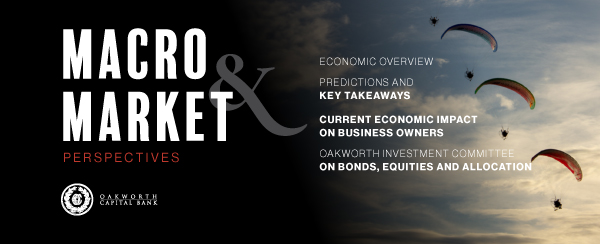The second quarter of the year proved to be a strong period for equity markets with continued gains across most major indices, moving higher in the face of plenty of question marks. Investors witnessed a notable upward trend as major stock indices reached the highest levels since last spring, defying continued concerns and demonstrating resilience.
Several factors contributed to this positive trajectory, including:
- A slowly improving (or not worsening, at the least) global economic outlook
- Resilient corporate earnings and
- A slowdown in the rate of monetary tightening
Amid this somewhat encouraging backdrop, long-term interest rates experienced a slight rise during the second quarter. Central banks in various countries cautiously shifted their stance, acknowledging the need to normalize monetary policy amid signs of modest economic growth. The modest increase in interest rates aimed to strike a delicate balance between supporting economic growth and mitigating inflationary pressures.
U.S. INTEREST RATES
Source: Bloomberg Financial
Overall, the second quarter presented investors with a favorable environment, combining strong equity market performance with a measured increase in interest rates. The road ahead continues to remain uncertain, but the positive momentum witnessed during this period offers a glimmer of hope for the remainder of the year.
Although the pace of hikes has decelerated from the rapid pace we saw in the back half of 2022, the trend continues, as the Federal Reserve shows no signs of slowing down its campaign to hike interest rates. This continues to evoke the phrase “higher for longer” in the financial media. This ongoing tightening of monetary policy has several implications for the economy and financial markets, making cash an increasingly attractive asset class.
INTEREST RATES
The Federal Reserve’s dual mandate of maximum employment and price stability has been the largest driver of the tightening cycle, and as inflation has and continues to slow, it has allowed Fed officials to take their foot off the gas, at least a little.
Rates are still going up, and the Fed has made it very clear that inflation is not where they want it to be. As long as that is the case, rates will remain high.
TIGHTENING CREDIT
However, as the Fed continues to hike interest rates, the cost of borrowing increases. This has a significant impact on businesses and consumers alike see articles: Economic Impact on the Consumer and Economic Impact on Business Owners. Higher borrowing costs can dampen corporate investment, making it more expensive for businesses to expand or undertake new projects. Similarly, individuals may find it harder to obtain affordable loans for major purchases such as homes or cars. This tightening of credit conditions can result in a slowdown in economic activity and slower growth.
So, what does this mean when looking through an asset allocation lens?
Rising interest rates can have negative consequences for borrowers, however, they present an opportunity for savers and investors.
Cash becomes a more attractive asset class because it offers a guaranteed return in the form of interest.
As interest rates rise, the yields on cash-based instruments, such as savings accounts, money market funds, and short-term certificates of deposit, also increase. This makes cash an appealing asset, and as we said last quarter, it continues to mean that we are comfortable with higher cash balances in an account. Cash, while always nice to have as dry powder, continues to be an actual asset. Currently the yield on cash in our portfolios is over 4.75%, and “higher for longer” implies that this will not go away any time soon. The concerns around higher interest rates won’t either.
INTERNATIONAL STOCKS
As we continue to assess our asset allocation, one shift we have opportunistically made is a gradual move back into international stocks, aimed at achieving a more balanced and market-weighted allocation. This decision has become an increasingly frequent topic of discussion within our Investment Committee, and we view it as not being pessimistic on domestic markets but rather gaining slightly more optimism toward developed international — essentially the G7 countries excluding the United States. When we zoom out and look at the bigger picture, we remain overweight to domestic equities.
SMALL CAP MOVEMENT
In addition to slightly rebalancing our international allocation, we have also begun exploring opportunities to add to our small cap allocation. This move signifies a shift toward an area that has underperformed. While large cap stocks continue to play a crucial role in our portfolio, we recognize the potential advantages of diversifying into smaller companies. As inflation comes down, and the yield curve begins to steepen, we believe there is potential for the smaller market capitalization companies to begin to outperform.
COVERED CALLS
Lastly, it is hard to ignore the rally that we have experienced so far this year and what that means for an asset allocation. Regardless of one’s take on whether the rally is going to continue or not, as asset managers, it’s our job to hedge when appropriate. Usually, the time to start mitigating some risk is the time that you don’t want to.
While we remain cautiously optimistic and do not want to remove ourselves from the market, we wanted to find some areas to hedge a little of the risk that always remains. For us that meant a fund that uses a covered call strategy. The fund uses options contracts that, while limiting the upside somewhat, also protect some of the downside by providing current income from the options contracts. This allows us to continue to remain in the equity markets, albeit with a more cautiously optimistic stance.
LOOKING AHEAD
Now, with some understanding of what we have done over the past quarter, the flip side is to understand where we think we are now, and where we think things are going. That is the other side of the investing coin and equally (if not more) important.
To recap the first half of the year, things have been largely led by what is being coined the Magnificent Seven. This moniker refers to Apple, Amazon, Microsoft, Alphabet (Google), Meta, Tesla and Nvidia. These names are all up over 35%, with Meta, Tesla and Nvidia up over 100% each. Nvidia is leading the charge, up almost 190% year to date. This has been where almost all the return so far has been generated for the S&P 500. While this is not necessarily something that forges a lot of confidence, it does leave open the possibility that some other names may be able to shoulder the load.
Inarguably the rally so far this year has been led by those seven names; however, at the same time the Advance/Decline line is at all-time highs. This is the technical indicator that plots the difference between advancing and declining stocks on a daily basis. It essentially tells traders whether more stocks are rising or falling. This signals that more and more names are starting to participate in the rally year to date.
This is largely what we think the next 12 months will look like and where our asset allocation changes over that timeframe will likely be based.
We believe that the market will become less reliant on the Magnificent Seven to lead the way and may, in fact, start to be supported more by the value side of things.
While we still have a large weighting toward tech and will likely continue to, our focus will be on areas where we think the returns will be generated over the next six to 12 months. The moves we have made so far this year show this. Small cap and international are two areas that have not driven the outsized returns so far this year; however, in a time where the returns start to be spread out amongst more than seven names, they should be some of the biggest benefactors.
While this year has been seemingly good on the surface, the underlying data continues to remain confusing and probably will remain that way for the foreseeable future. As always, we will continue to remain flexible and open to how the markets are changing and how we believe they should be interpreted.
For more from our Investment Committee in our 2nd Quarter 2023 Macro & Market Perspectives, click the image below.
The opinions expressed within this report are those of the Investment Committee as of the date published. They are subject to change without notice, and do not necessarily reflect the views of Oakworth Capital Bank, its directors, shareholders or employees.




